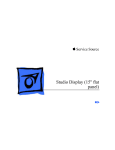Download Apple Mac OS X 10.2 Owner's Manual
Transcript
Read Before You Install Mac OS X This document provides important information you should read before you install Mac OS X. It includes information about supported computers, system requirements, and installing Mac OS X. For more information about Mac OS X, visit this Apple Web site: m www.apple.com/macosx/ For the latest information about this release of Mac OS X, connect to the Internet and open Mac Help. To open Mac Help, choose Mac Help from the Help menu in the Finder. For information about the support available for this product, see the “AppleCare Software Services and Support Guide” included with Mac OS X. Supported computers You can install this version of Mac OS X on any of the following computers: m Power Mac G4 m Power Macintosh G3 m PowerBook G4 m PowerBook G3 (except the original PowerBook G3) m iMac and eMac m iBook 1 System requirements Your computer must have m at least 128 MB of RAM m a built-in display or a display connected to an Apple-supplied video card The amount of disk space required depends on your computer and the way you are installing Mac OS X. If you see a message that you do not have enough disk space to install Mac OS X, you can deselect items to save space. Updating your computer's firmware Before you install Mac OS X, you may need to update your computer’s firmware. You must do so before you can install Mac OS X. You can find firmware updates for your computer on the Apple Software Updates Web site: m www.info.apple.com/downloads/ For example, if you have a Power Macintosh G3 (Beige) computer with an Apple Ultra Wide SCSI PCI card, you should update the firmware for the card using the Mac OS X SCSI Card Updater available on the Apple Software Updates Web site. Check for other updates by using Software Update preferences. Important You may need to update the software for printers and other devices you use with your computer. Check with the manufacturers of the devices for the latest update. Starting installation To start installing Mac OS X, double-click the Install Mac OS X icon on the Install Disc 1 CD. You can also start installing Mac OS X by restarting your computer while holding down the C key or selecting the Mac OS X Install Disc 1 CD as your startup disk using Startup Disk preferences. Quitting the Installer If you need to quit the Installer before you click Upgrade or Install in the Easy Install or Custom Install pane, choose Quit from the Installer application menu and click Restart, then hold down the mouse button to eject the Install Mac OS X CD. You may be able to eject the CD by pressing the eject button on your tray-loading CD drive or the Eject key on your keyboard. Your computer restarts using your current startup disk. If you have already clicked Upgrade or Install, wait until installation finishes. 2 Advice about hardware compatibility Identifying an original PowerBook G3 computer You cannot install Mac OS X on the original PowerBook G3 computer. This computer has a small, six-color Apple logo on the top cover of the display. You can also look on the bottom of the computer for the Family Number (M3553). Installing on a PowerBook G3 Series, an original Power Macintosh G3, or an iMac If you see a message when you select the destination disk that you need to install Mac OS X on a partition completely within the first 8 GB of disk space, choose Open Disk Utility from the Installer menu, then click Partition to see the partitions of your disk. The first partition is the top one. Select it and make sure it is 8 GB or less in size. If the first partition is larger than 8 GB or your hard disk only has one partition that is larger than 8 GB, you need to partition your disk again. Partitioning the disk erases the entire hard disk, so be sure to back up your files first. Installing on a Power Macintosh G3 (Blue and White) If you have a Power Macintosh G3 (Blue and White) that came with an Apple SCSI hard disk, do not choose UNIX File System (UFS) as the format for the destination disk. Installing on a computer with a third-party SCSI card If you have a third-party SCSI card installed in your computer and you cannot start up Mac OS X, attach a disk or SCSI terminator to one of the card’s ports. If you continue to have problems, try removing the card. Contact the manufacturer of the card for more information about using the card with Mac OS X. Installing on a computer with a third-party video card If you have a third-party video card installed in your computer, you may need to remove it before you install Mac OS X. Contact the manufacturer of the card for more information about using the card with Mac OS X. 3 Advice about installing Mac OS X Restoring your computer's software If you are restoring your computer's software and your computer came with Mac OS X v10.2 or later, follow the instructions that came with your computer to restore the software. Erasing and formatting your disk When you install Mac OS X, you can erase the destination disk. In the “Select a Destination” pane of the Installer, click the Options button. Select Erase and Install and then choose a format. In most cases, choose Mac OS Extended (HFS Plus). Be sure you have backed up your files before you erase the disk. To install Mac OS X on the same disk or disk partition as Mac OS 9, the disk must be in Mac OS Extended format. If it isn’t, you need to erase the disk. You can also divide your hard disk into several partitions before you install Mac OS X. Choose Open Disk Utility from the Installer menu and click Partition. Partitioning the disk erases the entire hard disk, so be sure to back up your files first. Important Do not choose UNIX File System (UFS) as the format for the destination disk unless you need to work with this format. If you choose UNIX File System, you must install Mac OS 9 and your Mac OS 9 applications on a Mac OS Extended format disk to use them with the Classic Environment. Reinstalling Mac OS X To reinstall Mac OS X, insert the Mac OS X Install Disc 1 CD and double-click the Install Mac OS X icon. Select the destination disk and click Options, then select “Archive and Install.” To save your existing users and groups, homes, and network settings, select the checkbox. The Installer saves your existing system files in a folder named Previous System. You cannot start up your computer using the Previous System folder. 4 Advice about using Mac OS X If you have problems starting up If you cannot start up your computer after you install Mac OS X, insert the Mac OS X Install Disc 1 CD and restart your computer while pressing the C key. Choose Open Disk Utility from the Installer menu, then click First Aid to repair the disk and disk permissions. If you have problems starting up your computer and you have devices connected to your computer such as FireWire drives, USB printers, or external displays, try disconnecting them before starting up again. Upgrading Mac OS 9 You should upgrade to the latest version of Mac OS 9. To use Mac OS 9 applications with the Classic Environment, you need Mac OS 9.1 or later. You can upgrade Mac OS 9 after you install Mac OS X. If you have a Mac OS 9 install CD, you can upgrade within the Classic Environment. If you want to upgrade using Software Update, you need to start up your computer using Mac OS 9. Upgrading your Classic applications and other software For best results with Mac OS X, upgrade your applications to versions that are built for Mac OS X. Check the Mac OS X Web site for information about available Mac OS X applications: m www.apple.com/macosx/ You can also check with the developers for the latest versions of your applications. If you cannot find a Mac OS X version of an application, upgrade to the latest Mac OS 9 version to use with the Classic Environment. Installing the latest version of the Startup Disk control panel To switch from Mac OS 9 to Mac OS X, use Startup Disk control panel version 9.2.2 or later. A recent version of the control panel is available on the Mac OS X Install Disc 1 CD. Setting up and connecting to the Internet If you have an existing Internet service provider (ISP) and you are installing Mac OS X for the first time, be sure to have your Internet connection information available so you can enter it after installation finishes. To learn more about the information you need, see the “Welcome to Mac OS X” PDF on the Mac OS X Install Disc 1 CD. If you cannot connect to the Internet, contact your ISP to make sure you have the correct information for Mac OS X. © 2002 Apple Computer, Inc. All rights reserved. Apple, the Apple logo, FireWire, iBook, iMac, Mac, Macintosh, PowerBook, Power Mac, and Power Macintosh are trademarks of Apple Computer, Inc., registered in the U.S. and other countries. eMac is a trademark of Apple Computer, Inc. 5















